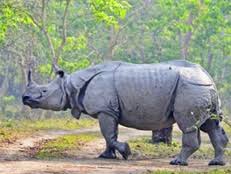DNA Sequencing of “Indian Rhino” 17/05/2019 – Posted in: Daily News – Tags: DNA sequencing, Indian Rhino, kaziranga national park
DNA-SEQUENCING OF INDIAN RHINO
For: Preliminary & Mains
Topic covers: DNA sequencing, About project- its importance & advantages, Indian Rhino, Kaziranga National Park and Tiger Reserve
News Flash
The Union Environment Ministry has embarked on a project to create DNA profiles of all rhinos in the country by 2021.
- The Indian rhino could be the first wild animal species in India to have all its members DNA-sequenced.
About the Project
- The exercise would be useful in curbing poaching and gathering evidence in wildlife crimes involving rhinos.
- Two proponents for the project are: World Wide Fund for Nature-India (WWF-India) and the Centre-funded Wildlife Institute of India (WII).
- 60 samples of tissue have been collected so far from some rhinos living outside Kaziranga. DNA Samples are also collected from dung.
- Once the entire project is completed, we’ll have a database that will be hosted in the Wildlife Institute of India (WII) headquarters in Dehradun.
Advantages
- Once the database is complete, identifying rhinos that were killed or poached would be easier.
- The project is a subset of the Centre’s larger, ongoing rhino conservation programme.
- Since the 1980s, the government has been trying to move a significant number of rhinos out of Kaziranga in the interest of the species’ conservation, threats from poaching and challenges to their habitat.
- We are also trying to have more rhinos in other locations in Assam itself such as Manas National Park and Pobitara Wildlife Sancutary.
Indian Rhino
- There are three species of rhinos, of which only one — the Indian rhino — is found in the country.
- The Indian rhinoceros lives primarily in northern India and Nepal.
- As their Latin name Rhinoceros unicornis suggests, Indian rhinos have only one horn.
- There are about 2,600 rhinos in India, with more than 90% of the population concentrated in Assam’s Kaziranga National Park.
- Outside Kaziranga, there are about 200 rhinos in West Bengal, 40 in Uttar Pradesh and 1 in Bihar.
Rhino Horn and Trafficking
The prominent horn for which these rhinos are so well known has also been their downfall. Many animals have been killed for this hard, hair-like growth, which is revered for medicinal use in China, Taiwan, Hong Kong, and Singapore. The horn is also valued in North Africa and the Middle East as an ornamental dagger handle.
Kaziranga National Park and Tiger Reserve
- Formed in 1908 on the recommendation of Mary Curzon, the park is located in the edge of the Eastern Himalayan biodiversity hotspots – Golaghat and Nagaon district.
- In the year 1985, the park was declared as a World Heritage Site by UNESCO.
- Kaziranga National park’s 430 square kilometer area sprinkled with elephant-grass meadows, swampy lagoons, and dense forests is home to more than 2200 Indian one-horned rhinoceros, approximately 2/3rd of their total world population.
- Along with the iconic Greater one-horned rhinoceros, the park is the breeding ground of elephants, wild water buffalo, and swamp deer.
- Over the time, the tiger population has also increased in Kaziranga, and that’s the reason why Kaziranga was declared as Tiger Reserve in 2006.
- Also, the park is recognized as an Important Bird Area by BirdLife International for the conservation of avifaunal species. Birds like lesser white-fronted goose, ferruginous duck, Baer’s pochard duck and lesser adjutant, greater adjutant, black-necked stork, and Asian Openbill stork specially migrate from the Central Asia during the winter season.
DNA Sequencing
- DNA sequencing is the process of determining the nucleic acid sequence – the order of nucleotides in DNA.
- It includes any method or technology that is used to determine the order of the four bases: adenine, guanine, cytosine, and thymine.
- The advent of rapid DNA sequencing methods has greatly accelerated biological and medical research and discovery.
- DNA sequencing may be used to determine the sequence of individual genes, larger genetic regions (i.e. clusters of genes or operons), full chromosomes, or entire genomes of any organism.
- DNA sequencing is also the most efficient way to indirectly sequence RNA or proteins (via their open reading frames).
- DNA sequencing has become a key technology in many areas of biology and other sciences such as medicine, forensics, and anthropology.
Source: The Hindu
You can follow us on LinkedIn and for more updates related to UPSC IAS Preparation, Like our Facebook Page and subscribe our Diligent IAS Youtube Channel
Also Read Related Daily News
- India International Institute of Democracy and Election Management (IIIDEM)
- MANAV : Human Atlas Initiative
- Coastal Regulation Zone Rules


